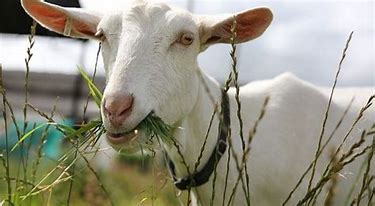

Grazing time in Goats can be influenced by several factors including the season of the year, the temperature and humidity, the topography of the land, the nature of the plant canopy, pasture availability and social interaction between animals. The season of the year, with changes in day length and intensity of sunlight, cause goats to graze in different patterns. At mean temperatures below 50°F, goats spend very little time grazing at night. At mean temperatures above 50°F, some grazing time will occur at night; and when mean temperatures exceed 77°F, one or more grazing periods will occur at night. During hot weather, frequent movement of goats during the day will increase intake.
The topography and size of the pasture also will have an effect on grazing time, as will forage availability and ease of forage removal. Sites within the pasture where urination and defecation have taken place and this can increase the time it takes to graze. Goats are generally sociable so if one animal gets up to graze, others will follow.
Control grazing and strip grazing
The basic principle of control grazing is to allow goats to graze for a limited time leaving a leafy stubble, and then to move them to another pasture or paddock (a subdivision of a pasture) or sub-paddock. Smaller paddocks are more uniformly grazed and surplus paddocks can be harvested for hay. The pasture forage plants, with some leaves still attached, can then use the energy from the sun through photosynthesis to grow back without using up all of their root reserves. Even brush will need a recovery time if it is being used as forage for goats. Without this rest period, the goats can kill the bush through continuous browsing.
Under control grazing, legumes and native grasses may reappear in the pasture, and producers often report that the pasture plant community becomes more diverse. Control grazing can be used to improve the pasture, extend the grazing season, and enable the producer to provide a higher quality forage at a lower cost with fewer purchased inputs. Control grazing can also be useful in reducing internal parasite problems, if meat goat producers are careful to move the goats to a new pasture before the forage plants are grazed too short (less than about 4 inches).
In addition, the use of the FAMACHA system to selectively deworm goats will overcome the problems of pasture infestations by resistant intestinal nematodes due to increased refugia. Refugia is the proportion of nematodes that provide a pool of susceptible genes and dilutes dewormer-resistant genes in that population.
Strip grazing can be easily superimposed on control grazing in large paddocks by placing movable electric fences ahead and behind the goats, giving them sufficient forage for 2 to 3 days. Strip grazing is very effective and results in high pasture utilization because otherwise goats will not graze soiled forage well. Strip grazing results in high average daily gain, increased gain per acre, and in rapid improvement of body condition when pasture is vegetative and of excellent quality such as during cool weather when plant quality declines only slowly. Strip grazing is very effective with stockpiled fescue during late fall and early winter. Strip grazing is not recommended when pasture is of low quality because of reduced goat selectivity.
 Contact Jaguza Support
Contact Jaguza Support